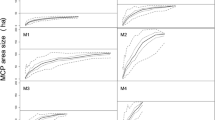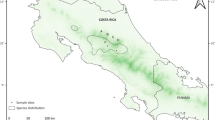Summary
-
1.
Ranging behavior in a nonmigratory population of white-crowned sparrows Zonotrichia leucophrys nuttalli residing in the coastal scrub habitat of central California was studied by trapping and recapture. Over 12,000 captures of more than 1,700 individuals were analyzed. In their first breeding season, young Z. l. nuttalli produced from early broods bred near their own hatching site, but those from later broods bred farther away (Fig. 3).
-
2.
As adults, females had more restricted movements in summer than did males. In winter, females expanded their ranging movements more than males. We hypothesized that higher vagility of females in winter is related to their being socially subordinate to males in flocks. This causes them to wander among different flocks or to live a solitary existence.
-
3.
Employing a bivariate statistical model we found the most satisfactory description of home range size to be given by a 50% equal frequency ellipse. By this method, the average Z. l. nuttali home range was estimated to be 6–7 ha (Fig. 6).
-
4.
The home range of four other passerines in the same trap system has been estimated previously. We compared our results on Z. l. nuttalli with reported results on the four other passerines to examine the relationship between home range size and body size among granivores. The best-fit line has the equation: home range (ha)=0.044 W(g)1.31 (Fig. 7). The slope of this line is much steeper than that published for the relationship of mammalian home range and body size and is slightly steeper than indicated by previous work on birds. Our slope is also steeper than that of the relationship between standard metabolic rate and body size for passerines but is similar to a theoretically derived regression coefficient describing the power required for flight in relation to body size. We hypothesized that in birds the energetic demands of flight have influenced the evolution of home range size.
Similar content being viewed by others
References
Aschoff, J., Pohl, H.: Der Ruheumsatz von Vögeln als Funktion der Tageszeit und der Körpergröße. J. Ornithol. 111, 38–47 (1970)
Baker, M.C., Mewaldt, L.R.: Song dialects as barriers to dispersal in white-crowned sparrows, Zonotrichia leurophrys nuttalli. Evolution 32, 712–722 (1978)
Berger, M., Hart, J.S.: Die Atmung beim Kolibri Amazilia fimbriata während des Schwirrfluges bei verschiedenen Umgebungstemperaturen. J. Comp. Physiol. 81, 363–380 (1972)
Berger, M., Hart, J.S.: Physiology and energetics of flight. Avian Biol. 4, 415–477 (1974)
Brown, J.L., Orians, G.H.: Spacing patterns in mobile animals. Annu. Rev. Ecol. Syst. 1, 239–262 (1970)
Calhoun, J.B., Casby, J.U.: Calculation of home range and density of small mammals. U.S. Public Health Monogr. 55, 1–24 (1958)
Cavalli-Sforza, L.L., Kimura, M., Barrai, I.: The probability of consanguineous marriages. Genetics 54, 37–60 (1966)
Custer, T.W., Pitelka, F.A.: Time-activity patterns and energy budget of nesting lapland longspurs near Barrow, Alaska. Tundra Biome Symp. Proc., Lake Wilderness Center, Univ. Wash., pp 160–164 (1972)
Dhondt, A.A., Hublé, J.: Fledging-date and sex in relation to dispersal in young great tits. Bird Study 15, 127–134 (1968)
Dice, L.R., Clark, P.J.: The statistical concept of home range as applied to the recapture radius of the deermouse (Peromyscus). Contrib. Lab. Vertebr. Biol. Univ. Mich. 62, 1–15 (1953)
Halliburton, R., Mewaldt, L.R.: Survival and mobility in a population of Pacific Coast song sparrosw (Melospiza melodia gouldii). Condor 78, 499–504 (1976)
Hayne, D.W.: Calculation of size of home range. J. Mammal. 30, 1–18 (1949)
Jennrich, R.I., Turner, F.B.: Measurement of non-circular home range. J. Theor. Biol. 22, 227–237 (1969)
Kendeigh, S.C.: Tolerance of cold and Bermann's rule. Auk 86, 13–25 (1969)
Kerster, H.W.: Neighborhood size in the rusty lizard, Sceloporus olivaceus. Evolution 18, 445–457 (1964)
King, J.R.: Seasonal allocation of time and energy resources in birds. In Avian energetics. Paynter, R.A., Jr. (ed.), pp. 4–70. Cambridge, Mass.: Publ. Nuttall Ornithol. Club 1974
Koeppl, J.W., Slade, N.A., Hoffman, R.S.: A bivariate home range model with possible application to ethological data analysis. J. Mammal. 56, 81–90 (1975)
Kokshaiski, N.V.: Flight energetics in insects and birds. Zh. Obshch. Biol. 31, 527–549 (1970)
Madden, R., Marcus, L.F.: Use of the F distribution in calculating bivariate normal home ranges. J. Mammal. 59, 870–871 (1978)
McNab, B.K.: Bioenergetics and the determination of home range size. Am. Nat. 97, 133–140 (1963)
Mewaldt, L.R., King, J.R.: The annual cycle of white-crowned sparrows, Zonotrichia leucophrys nutalli, in coastal California. Condor 79, 445–455 (1977)
Mohr, C.O., Stumpf, W.A.: Comparison of methods for calculating areas of animal activity. J. Wildl. Manage. 30, 293–304 (1966)
Munz, P.A., Keck, D.D.: A California flora. Berkeley: Univ. Calif. 1959
Odum, E.P., Kuenzler, E.J.: Measurement of territory and home range size in birds. Auk 72, 128–137 (1955)
Pennycuick, C.J.: Power requirements for horizontal flight in the pigeon Colombia livia. J. Exp. Biol. 49, 527–555 (1968)
Schoener, T.W.: Sizes of feeding territories among birds. Ecology 49, 123–141 (1968)
Shrout, D.A.: Population studies of the brown towhee and the rufous-sided towhee. Unpublished Master's thesis, San Jose State University, San Jose, California (1972)
Sokal, R.R., Rohlf, F.J.: Biometry, San Francisco: W.H. Freeman 1969
Stewart, R.M., Darling, K.: Winter social hierarchy of white-crowned sparrows. Point Reyes Bird Obs. Newsl. 22, 2–3 (1972)
Utter, J.M., LeFebvre, E.A.: Daily energy expenditure of purple martins (Progne subis) during the breeding season: Estimates using D2O18 and time budget methods. Ecology 54, 597–604 (1973)
Vargas, D.J.: Observations on winter ecology and morphology of the golden-crowned sparrow. Unpublished Master's thesis, San Jose State University, San Jose, California (1971)
Author information
Authors and Affiliations
Additional information
Contribution No. 155, Point Reyes Brid Observatory
Rights and permissions
About this article
Cite this article
Baker, M.C., Mewaldt, L.R. The use of space by white-crowned sparrows: Juvenile and adult ranging patterns and home range versus body size comparisons in an avian granivore community. Behav Ecol Sociobiol 6, 45–52 (1979). https://doi.org/10.1007/BF00293244
Received:
Accepted:
Issue Date:
DOI: https://doi.org/10.1007/BF00293244




